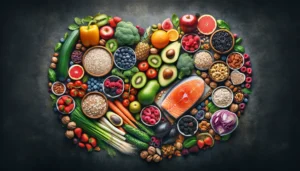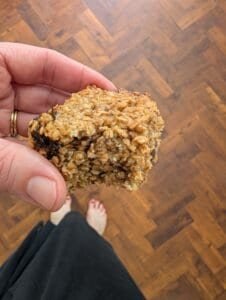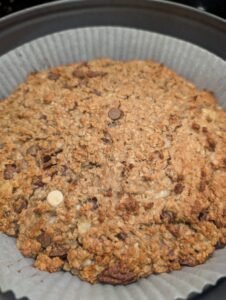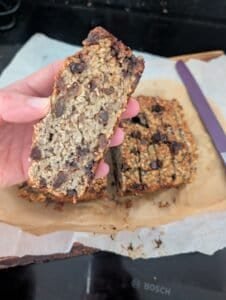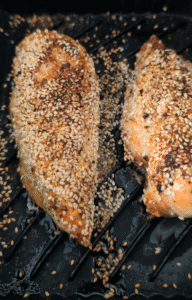Porridge bread is ideal for a whole host of reasons.
- As a gluten free or wheat free bread option (*use gluten free oats).
- For those who don’t like the texture of porridge but want to reap the benefits of oats.
- For those that want a breakfast option on the go.
- To increase oat consumption in a bid to lower cholesterol.
- As a method to better manage constipation or gut issues.
- For soluble fibre’s help in managing blood sugar levels.
- The list is endless but of course includes ‘because it’s tasty’.
What you’ll need to make it
This recipe is ideal as you don’t need to measure anything. Just lash it into the bowl and mix it up. It super handy if in a rush, and I can make it anywhere (including our camper van!). If you want the recipe using grams not cups, see below.
- Bag of oats
- Tub of natural yoghurt/ soy yoghurt
- 1 tsp salt
- 2 tsp baking soda/ baking powder (us the powder if making it with soya yoghurt)
Porridge bread recipe using grams
Some people feel passionately about getting recipes with grams, while some prefer everything in cups or with straightforward instructions as above. Whatever camp you’re in, I have you covered. I’ve tried and tested this lots to make sure the below is correct. I love adding a few eggs, I feel it adds protein and nutrients, and adds to the flavour and texture. If using greek yoghurt you may require a drop of milk to make sure the mixture is nice and moist.
If it doesn’t rise enough for you, preheat the oven at 200 degrees celcius and pop it in for 10 minutes at that higher temp before bring it down to about 170 for the remainder. Score the top in a criss cross too. And, I think baking soda works better than baking powder. However, some people feel they taste it, so if that’s the case use a tsp of both!
- 500g yoghurt
- 360g oats
- 2 flat tsp baking soda
- 1-2 eggs (optional)
How to cook it
- Simply place 500g of natural yoghurt into a bowl (the large tub). Use plain soy yoghurt if following the Low FODMAP diet (stick to 1-2 small slices) or for those on a dairy free diet.
- Fill the tub (empty yoghurt carton) with oats and place the oats into the bowl too (in other words, the empty yoghurt tub works as a measure and you’re about to add 1 part yoghurt, 2 parts oats to the bowl).
- Now repeat this second step again so 2 tubs-worth of oats are in the bowl with the yoghurt (you might call it a yoghurt pot instead of a tub!).
- Then add in 1 tsp of salt and 2 tsp of baking soda (use baking powder if following Low FODMAP/ dairy free option and using soya yoghurt). Mix well and put into a greased bread tin.
- Cook in a preheated oven for 50 mins at 180 degrees C or until it sounds hollow when you knock the bottom of the loaf.
Help – ‘My porridge bread is flat’ ‘My porridge bread hasn’t risen’
I get this comment a lot. So, let me help you. 10 things;
- Make sure the oven is hot enough. Preheat it till you’re absolutely sure.
- Start the oven at 200 degrees celcius if needed, for about 10 minutes, and then reduce it to 170 degrees until done. See if that makes a difference.
- Everyone’s oven is different so it’s tricky to apply general guidance to your oven. If it’s too hot, the outside may have set before the inside expands. If it’s too cold it won’t rise as well as it doesn’t set quickly enough to trap the air within it. Maybe you know which camp you fall in?
- Mix the baking powder with the oats before adding the yoghurt can help as sometimes the baking soda hasn’t reached enough yoghurt.
- Sometimes you need to leave it a minute or two to allow the baking soda to interact with the yoghurt.
- It’s crucial not to overmix you risk knocking the air out of it.
- It may be too wet or too dry. I know… Another situation where you’re going to have to guess which camp you’re in. Basically you don’t want it sloppy as super wet mixture won’t trap air. But, on the other hand you don’t want it to be super dry that you can barely move the spoon about as dry mixture won’t expand.
- Baking soda usually works better than baking powder. Use baking powder with soya yoghurt as the soda needs the cows yoghurt. If you don’t like using 2 tsp of baking soda (some people can taste it while some can experience gut upset), then using 1 tsp of baking soda and 1 tsp of baking powder.
- Don’t squish the oat mixture into the tin too much. Place it in and then smooth it down a bit, but don’t squish it like you’re making flapjacks.
- Could your baking soda be out of date?
Why eat oats? What are the Nutritional Benefits of oats?
- Consumption of beta-glucans that are naturally found within oats as part of a meal helps to reduce the blood sugar rise after that meal.
- In my porridge bread recipe above there is 1732kcal, 60g protein and 28g fibre. If you cut it into 14 slices, there will be 124 calories, 4g of protein and 2g of fibre per slice.
- There is 1634 calories, 98g protein and 25g fibre (there or there abouts) in high protein porridge bread. If you use 0% greek and the recipe on my page. That’s 117 calories per slice (if you cut 14 slices), 7g proteain and 2g fibre.
- Porridge bread can be cholesterol lowering – please see the details below.
- With only 36g yoghurt (1.8 g of lactose per slice) found in each slice, porridge bread is lower in lactose than people think. Most people with lactose intolerance could tolerate that amount of lactose.
Is porridge bread cholesterol lowering?
- The beta-glucans in oats can lower cholesterol levels.
- Adding flaxseed/ linseed to your porridge bread will provide plant omegs 3 called ALA. ALA helps lower cholesterol levels.
- Making chia jam with chia seeds also provides ALA omega 3 fat. So, will help boost your intake in the tastiest of ways.
- Making your porridge bread with soya yoghurt can lower cholesterol levels further. It’s not that dairy is bad for you heart. it’s simply that soy has cholesterol lowering abilities.
- Plant stanol esters found in cholesterol lowering drinks have been shown to reduce blood cholesterol. So, having this drink with your breakfast may provide additional benefits.
- Finally, switching the butter on your bread (high in saturated fats) with peanut or almond butter (unsaturated fats) lowers cholesterol levels



